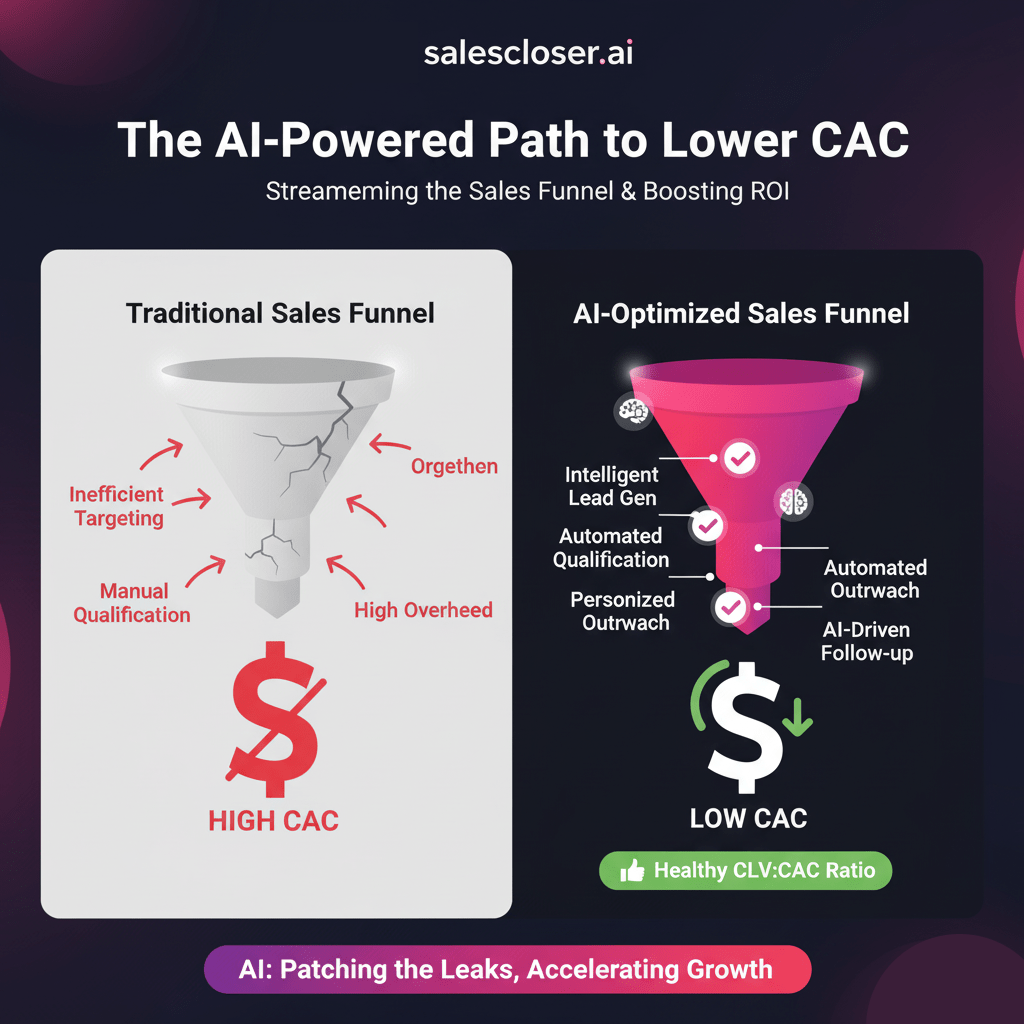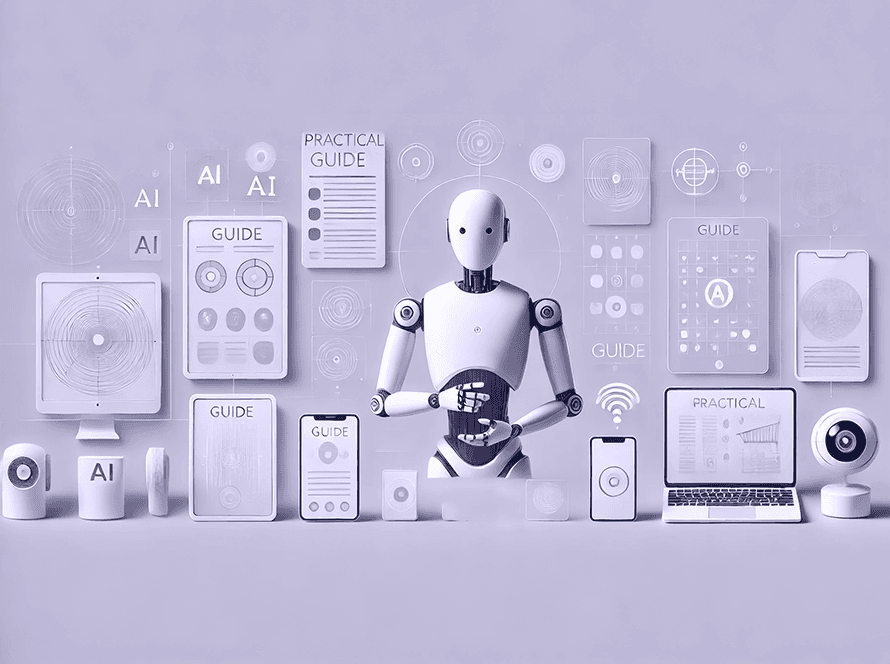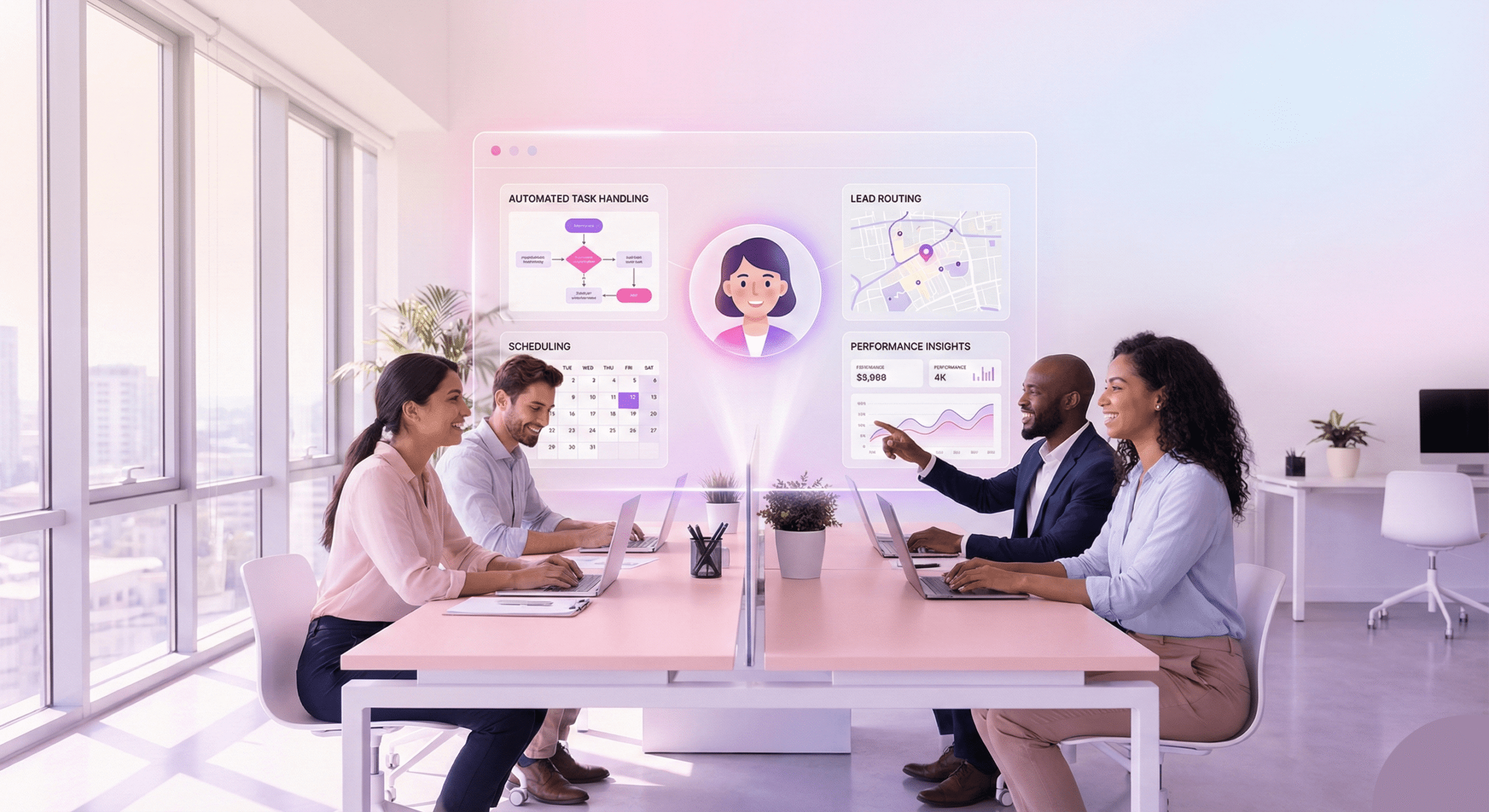“Automate prospecting, supercharge lead qualification, and slash administrative overhead to reduce customer acquisition cost with AI drastically.”
Are you investing money in marketing and sales, only to see the cost of acquiring a single new customer rise higher and higher? You’re not alone. Many businesses feel like they’re on a treadmill, spending more just to stay in the same place. This ever-increasing expense, your Customer Acquisition Cost (CAC), is more than just a line item on a spreadsheet. It’s a silent threat that can drain your resources, cripple your cash flow, and ultimately decide the fate of your business.
But what if you could fundamentally change the equation? Imagine an acquisition engine that works 24/7, engages prospects with perfect precision, and costs a fraction of traditional methods. This isn’t a far-off fantasy; it’s the reality made possible by Sales AI.
This guide is your blueprint for tackling high CAC head-on. We’re going to break down why your costs are soaring and provide you with a strategic playbook on how to reduce customer acquisition costs (CAC) with AI. Forget abstract theories. We’re discussing actionable strategies that utilize AI to create a more efficient, scalable, and profitable growth engine. Let’s get started.
The CAC Conundrum: Why Your Acquisition Costs Are Out of Control
Before we can fix the problem, we need to understand it completely. Customer Acquisition Cost (CAC) refers to the total cost of all sales and marketing efforts necessary to acquire one new customer. The formula is deceptively simple:
$$\text{CAC} = \frac{\text{Total Sales & Marketing Costs}}{\text{Number of New Customers Acquired}}$$
Let’s break down what goes into those “Total Sales & Marketing Costs.” It’s not just your ad spend on Google or Facebook. It includes:
- Salaries and Commissions: The compensation for your entire sales and marketing team.
- Advertising Spend: The direct cost of pay-per-click (PPC), social media ads, content syndication, etc.
- Software & Tools: The subscriptions for your CRM, marketing automation platforms, analytics tools, and more.
- Content & Creative: The costs of creating blog posts, videos, graphics, and other marketing assets.
- Overhead: A portion of the general business costs that support the sales and marketing functions.
So, if you spend $50,000 in a month on all of the above and acquire 50 new customers, your CAC is $1,000. That number, in isolation, means nothing. Its true power comes when you compare it to another critical metric: Customer Lifetime Value (CLV).
The All-Important CLV: CAC Ratio
CLV is the total revenue you expect to generate from a single customer throughout their entire relationship with your company. The ratio of CLV to CAC is the ultimate health indicator for your business model.
- 1:1 Ratio (The Danger Zone): You’re spending as much to acquire a customer as they will ever spend with you. You’re losing money with every new sale.
- 3:1 Ratio (The Sweet Spot): This is widely considered the gold standard. For every dollar you spend on acquisition, you get three dollars back over the customer’s lifetime. Your business is profitable and has a sustainable growth model.
- 5:1+ Ratio (The Growth Machine): You have an incredibly efficient acquisition engine. You’re likely dominating your market and should invest more in sales and marketing to continue growing at an even faster pace.
Another key metric tied to this is the CAC Payback Period. This is the number of months it takes for you to recoup the money spent acquiring a customer. If your CAC is $1,000 and your customer pays you $100 per month, your payback period is 10 months. A shorter payback period means healthier cash flow, allowing you to reinvest in growth sooner.
So, Why Is Your CAC So High?
If your CLV: CAC ratio is looking unhealthy, it’s likely due to one or more of these common culprits:
- Saturated Channels & Rising Ad Costs: The digital advertising space is an auction. As more competitors enter, the cost per click and cost per impression skyrocket. Relying solely on these channels becomes a game of diminishing returns.
- A Leaky Sales Funnel: You spend a fortune to attract 1,000 visitors to your site (automating the top of the funnel is key here), but only 50 sign up for a demo, and only 2 become customers. Every drop-off point is a leak where you’re losing money. An efficient sales funnel is non-negotiable.
- Inefficient Sales Teams: Your highly paid sales representatives are spending less than a third of their day actually selling. The rest of their time is consumed by administrative tasks, including logging data in the CRM, scheduling meetings, sending follow-up emails, and prospecting for leads who are unlikely to buy. This is a significant drain on resources and a direct contributor to high sales team overhead.
- Poor Lead Quality: Marketing is sending a firehose of leads to sales, but most are unqualified. Your sales team wastes precious time and energy chasing ghosts, which inflates the cost of acquiring the few who do convert. This results in a lower cost per lead being an unachievable dream.
- Long and Complex Sales Cycles: The longer it takes to close a deal, the more resources (salaries, time, tools) it consumes. Delays, missed follow-ups, and inefficient processes all stretch the sales cycle and drive up your CAC.
These problems compound, creating a vicious cycle of spending more and getting less. Breaking this cycle requires a fundamental shift in strategy, moving from brute force to intelligent automation.
A Tale of Two Sales Teams: The Old Guard vs. The AI-Powered Future
To truly grasp the impact of AI, let’s compare two different approaches to sales. You might recognize the first one.
The Old Guard: A Day in the Life of a Traditional Sales Rep
Meet Alex. Alex is a good salesperson. He starts his day with a giant list of leads in a spreadsheet.
- 9 AM – 11 AM: Manual Prospecting. Alex scours LinkedIn and company websites, searching for contact information to connect with potential leads. It’s tedious, repetitive work.
- 11 AM – 1 PM: Cold Calling. Alex dials number after number, facing rejection, voicemails, and gatekeepers. For every 50 calls, he might have one meaningful conversation.
- 1 PM – 2 PM: Lunch and CRM Entry. He spends his lunch break manually entering notes from the morning’s calls into the CRM, a task he dreads.
- 2 PM – 4 PM: Sending Generic Emails. Alex blasts out a template email to a list of 100 prospects, changing only the {{first_name}} and {{company_name}}. The open and reply rates are abysmal.
- 4 PM – 5 PM: Internal Meetings and Follow-ups. He tries to chase down prospects who showed interest last week, but it’s hard to keep track of who needs what and when.
Alex is working hard, but he’s not working smart. His process is inefficient, not scalable, and heavily reliant on luck and brute force. His company’s CAC is high because most of Alex’s expensive time is spent on non-selling activities.
The New Wave: A Day with an AI-Powered Sales Agent
Now, meet Sarah. Sarah is also a salesperson, but her company has embraced Sales AI. Her “teammate” is an AI Sales Agent.
- Overnight: The AI agent analyzed the company’s ICP, scoured the web for thousands of potential leads that fit the criteria, found their contact information, and initiated a hyper-personalized email sequence for each one.
- 9 AM: Sarah logs in. Her dashboard doesn’t show a list of cold leads. It shows a prioritized list of 15 warm leads that the AI has already qualified. The AI has already engaged them, answered their initial questions via chat or email, and even booked demos directly onto Sarah’s calendar.
- 9 AM – 1 PM: Back-to-Back Demos. Sarah spends her entire morning doing what she does best: talking to interested, qualified buyers. She’s not prospecting or scheduling; she’s building relationships and closing deals. The AI agent has already provided her with a complete history of its interactions with each prospect, so she’s fully prepared.
- 1 PM – 2 PM: Strategic Lunch. Sarah uses her break to review AI-generated analytics on which sales pitches are working best and identify bottlenecks in the sales process.
- 2 PM – 4 PM: High-Value Deal Strategy. Sarah focuses her attention on a complex, high-value enterprise deal. She collaborates with her human colleagues while the AI agent handles all the routine follow-ups for her other mid-market deals.
- 4 PM – 5 PM: Review and Refine. Sarah reviews the AI agent’s performance, tweaks its outreach messaging, and sets the strategy for the next day’s automated campaigns. All call notes and CRM updates have been done automatically.
Sarah is a strategic closer, not an administrative assistant. Her company’s CAC is a fraction of Alex’s because the most expensive and time-consuming parts of the sales process are automated. This is the power of a modern sales motion.
The AI Playbook: 5 Proven Strategies to Decimate Your CAC
Now for the core of our guide. Here are five concrete strategies you can implement using Sales AI to lower your acquisition costs and boost your marketing ROI dramatically.
Strategy 1: Automate the Top of Your Funnel for Truly Scalable Lead Generation
The top of the sales funnel (ToFu) is a volume game. It’s traditionally where you spend the most money and manual effort to generate initial interest. This is the perfect place for AI to take over.
- The Problem: Manually building lead lists, sending cold emails, and making initial contact are soul-crushing and inefficient processes for your Sales Development Reps (SDRs). It’s a high-effort, low-yield activity that directly inflates your CAC.
- The AI Solution: An AI Sales Agent can work 24/7 to execute these tasks at a scale no human team could ever match.
- Intelligent Prospecting: AI analyzes your existing customer data to build a perfect Ideal Customer Profile (ICP). It then scours the web, professional networks like LinkedIn, and data providers to find thousands of prospects who match this profile in real-time.
- Automated, Personalized Outreach: Say goodbye to generic templates. Generative AI crafts unique, personalized outreach messages for each prospect based on their role, industry, recent company news, or even posts they’ve shared on social media. This leads to drastically higher open and response rates.
- Continuous Engagement: The AI doesn’t just send one email and give up. It executes a multi-touch sequence across email and other channels, nurturing cold leads until they’re ready to talk.
- The Impact on CAC: You achieve scalable lead generation without scaling your payroll. You generate a higher volume of better-quality leads for a fraction of the cost of a human-led SDR team, directly lowering your cost per lead.
Strategy 2: Supercharge Lead Qualification and Scoring
One of the most significant hidden costs in any sales organization is the time wasted on tire-kickers. Sales reps spend hours on calls with people who don’t have the budget, authority, or real need for their product.
- The Problem: A poor qualification process means your most expensive resource—your closers’ time—is squandered on dead-end conversations. This stretches your sales cycle and tanks your conversion rates.
- The AI Solution: AI acts as the ultimate gatekeeper, ensuring only sales-ready leads reach your human team.
- Predictive Lead Scoring: AI models can analyze dozens of signals—demographics, firmographics, website behavior (e.g., pages visited, content downloaded), email engagement—to assign a “lead score” to each prospect. This enables your team to prioritize the most promising leads instantly.
- Conversational Qualification: AI chatbots or voice agents can engage leads on your website or over the phone, facilitating seamless interactions. They can ask critical BANT (Budget, Authority, Need, Timeline) questions in a natural, conversational way. A lead is only booked on a human’s calendar after the AI has vetted it.
- The Impact on CAC: Your sales team’s productivity skyrockets. They spend their days in high-quality conversations, which dramatically improves sales efficiency metrics. Conversion rates go up, the sales cycle shortens, and your CAC plummets.
Strategy 3: Deliver Hyper-Personalization at Unprecedented Scale
“Personalization” used to mean inserting a first name into an email. Today’s buyers expect much more. They expect you to understand their business, their challenges, and their goals. Delivering this level of personalization manually is impossible at scale.
- The Problem: Generic, one-size-fits-all messaging gets ignored. To cut through the noise, you need to be relevant. But dedicating human time to research and customizing every single interaction is prohibitively expensive.
- The AI Solution: AI makes one-to-one personalization a one-to-many reality.
- Dynamic Content Creation: AI can create tailored sales collateral on the fly. It can generate a custom presentation slide that addresses a prospect’s specific pain point or draft an email that references their company’s latest quarterly report.
- Real-Time Conversation Intelligence: During a sales call, AI can listen in, analyze the conversation, and provide the human representative with real-time suggestions for talking points, relevant case studies to mention, or answers to complex questions.
- Behavior-Triggered Outreach: AI can monitor buying signals and automatically trigger outreach. Did a prospect just visit your pricing page for the third time? The AI can instantly send a follow-up offering to answer any questions about the plans.
- The Impact on CAC: You experience a significant increase in engagement and response rates across your entire funnel. By making every touchpoint more relevant, you increase your conversion velocity. This is key to improving marketing ROI—you get more results from the same ad spend and effort.
Strategy 4: Slash Sales Team Overhead and Maximize Selling Time
Your sales reps are knowledge workers. Their unique value comes from their ability to empathize, strategize, and persuade. Yet, studies consistently show they spend up to 70% of their time on tasks that have nothing to do with selling.
- The Problem: Administrative burden is a silent killer of productivity. CRM updates, scheduling, reporting, and writing follow-up emails are necessary but low-value activities that consume hours every day, and reducing sales team overhead is a challenge.
- The AI Solution: AI becomes the ultimate sales assistant, automating the administrative work so your team can focus on what generates revenue.
- Automated Data Entry: After a call, the AI can automatically transcribe the conversation, summarize the key takeaways, and update the relevant fields in your CRM—no more manual note-taking.
- Intelligent Scheduling: AI can handle the endless back-and-forth of finding a meeting time. It can sync with both the representative’s and the prospect’s calendars and automatically find a mutually agreeable time slot.
- Automated Follow-ups: Based on the outcome of a meeting, the AI can trigger the appropriate follow-up sequence, whether it’s sending a proposal, a case study, or a simple check-in email. This ensures no lead ever falls through the cracks.
- The Impact on CAC: You dramatically improve your sales automation ROI. Your existing team can handle a higher volume of leads with less stress and burnout. You can grow revenue without needing to hire more salespeople, which directly and significantly lowers your CAC.
Strategy 5: Optimize Your Entire Sales Funnel with Predictive Analytics
You can’t fix what you can’t measure. Many companies struggle with high CAC because they don’t have clear visibility into where their funnel is broken.
- The Problem: Gut feelings and incomplete data lead to bad decisions. You might be pouring money into a marketing channel that brings in lots of leads, but none of them ever close.
- The AI Solution: AI acts as a data scientist for your sales team, uncovering insights that would be impossible for a human to find.
- Funnel Bottleneck Identification: AI can analyze data from your CRM, marketing platform, and call recordings to pinpoint precisely where prospects are dropping off. Is it after the first demo? After you send the proposal? AI gives you the data to fix the leak.
- Deal-Closing Prediction: AI can analyze all the variables of an open deal—such as engagement level, prospect title, company size, and products discussed—and predict its likelihood of closing. This helps sales leaders create more accurate forecasts and direct their team’s coaching efforts where they’re needed most.
- Attribution Analysis: AI can help you understand which marketing campaigns and sales activities are actually driving revenue, allowing you to double down on what works and cut what doesn’t.
- The Impact on CAC: You move from reactive problem-solving to proactive optimization. By continuously refining your process based on data-driven insights, you create an increasingly efficient sales funnel, ensuring that every dollar you invest in sales and marketing is maximized.

Your Unfair Advantage: Introducing SalesCloser.ai, the Autonomous AI Sales Agent
We’ve explored the strategies. Now, let’s discuss the ultimate tool for executing them. While many tools can automate a small piece of the puzzle, SalesCloser.ai is a comprehensive platform designed to be your autonomous AI sales agent, handling the entire sales cycle from prospecting to closing.
SalesCloser.ai isn’t just another chatbot or email automation tool. It’s a sophisticated AI that can reason, communicate, and perform the tasks of a top-tier sales professional. Here’s how its specific features directly map to the CAC reduction strategies we’ve discussed.
Feature: Handles Phone and Video Calls 24/7
This is a game-changer. SalesCloser.ai can join a live call, understand conversational nuances, answer questions, and guide a prospect through a presentation.
- CAC Reduction Link: This directly automates the most time-consuming aspects of the sales process, including discovery calls and initial demos. It provides scalable lead generation and qualification without human intervention. Imagine qualifying leads in different time zones while your team sleeps. This dramatically reduces sales team overhead and accelerates your sales cycle.
Feature: Automated Scheduling & Follow-ups
SalesCloser.ai eliminates the administrative black holes that consume your team’s time. After qualifying a lead, it seamlessly books the next step—a strategic call with a human account executive—directly on their calendar. It also ensures persistent, timely follow-up.
- CAC Reduction Link: This directly attacks sales inefficiency. By automating these tasks, you free up hundreds of hours for your team to focus on other priorities. This shortens the CAC payback period by preventing deals from stalling due to slow human follow-up.
Feature: Personalized Product Demonstrations
The AI doesn’t just give a canned presentation. Based on its initial qualification conversation, it can deliver a personalized product demonstration that focuses on the specific features and benefits most relevant to that prospect.
- CAC Reduction Link: Personalization drives conversions. By delivering a perfect, tailored demo every single time, SalesCloser.ai creates a more efficient sales funnel. Higher demo-to-close rates mean your acquisition cost for each customer drops significantly.
Feature: Customer Support Assistance & Upselling
The job isn’t done once the customer is acquired. Retention is crucial. SalesCloser.ai can handle Tier 1 customer support inquiries, freeing up your support team to focus on more complex issues. More importantly, it can identify upsell and cross-sell opportunities with existing customers.
- CAC Reduction Link: This powerfully impacts the Customer Lifetime Value (CLV) side of the equation. Acquiring new revenue from existing customers is the lowest-CAC revenue you can get. By increasing CLV, you make your entire acquisition model more robust and profitable.
By integrating these capabilities into a single platform, SalesCloser.ai provides a powerful, end-to-end solution for a company’s most pressing growth challenge: acquiring customers profitably and at scale.
Stop Burning Cash, Start Building an Acquisition Machine
The battle for growth is no longer won by outspending your competitors. It’s won by outsmarting them. Relying on outdated, manual sales processes in the age of AI is like bringing a horse to a car race. You might be working hard, but you’re destined to fall behind.
High customer acquisition costs are a symptom of an inefficient system—a system bogged down by repetitive tasks, wasted time, and missed opportunities. Sales AI is the cure. It automates the mundane, empowers your team to be strategic, and transforms your sales funnel into a well-oiled, data-driven machine.
AI isn’t here to replace your talented salespeople. It’s here to unleash them. It allows them to stop being administrators and start being expert closers and trusted advisors.
Platforms like SalesCloser.ai represent the next evolution of sales. They provide the leverage you need to do more with less, turning your acquisition strategy from a cost center into a powerful engine for profitable, scalable growth.
Ready to see how an AI Sales Agent can cut your CAC in half? Book a demo with SalesCloser.ai today and build your own AI-powered sales force.
Frequently Asked Questions (FAQs)
Q1: Will Sales AI replace my human sales team?
No, it augments them. Think of it as giving your star player a robotic exoskeleton. The AI handles the heavy lifting—prospecting, qualifying, scheduling, and follow-ups—so your human team can focus on what they do best: building strategic relationships, navigating complex negotiations, and closing high-value deals.
Q2: Is implementing Sales AI complicated and expensive?
It’s more accessible than you think. Modern platforms like SalesCloser.ai are designed for seamless integration with your existing CRM and workflows. When you calculate the sales automation ROI from reduced CAC, increased sales productivity, and accelerated growth, the cost is often significantly lower than hiring, training, and paying another human salesperson.
Q3: How does AI actually improve lead quality?
AI improves lead quality in two main ways. First, it utilizes data analysis to identify prospects that precisely match your Ideal Customer Profile, meaning you start with a more targeted pool of leads. Second, it engages these leads in initial conversations (via call, email, or chat) to vet their needs, budget, and authority before they ever require a human representative’s time.
Q4: Can an AI really handle a sophisticated sales call?
Absolutely. Modern conversational AI is light-years beyond the robotic phone trees of the past. For initial discovery calls, lead qualification, and standardized product demos, an AI agent can perform with flawless consistency. It never has a bad day, never forgets to ask a key question, and ensures every prospect gets the same high-quality experience.
Q5: What’s the first practical step to reducing CAC with AI?
Start with an audit. Look at your current sales and marketing funnel and ask: “Where is the most time and money being wasted?” Is it at the top of the funnel with manual prospecting? Is it in the middle with unqualified demos? Once you identify your biggest bottleneck, you can find an AI solution that directly addresses that specific pain point, ensuring the fastest possible return on your investment.








